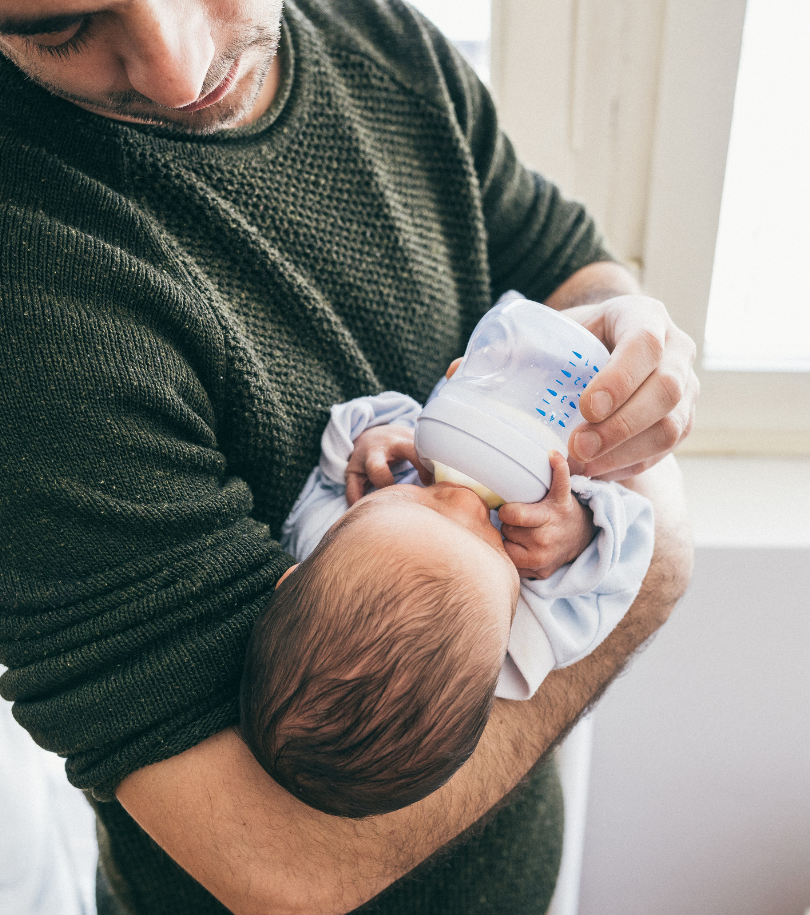- Home
- Health Topics
- Pregnancy to Parenthood
- Infant Formula: The Facts
Infant Formula: The Facts
Here is important and basic information about preparing and storing infant formula safely. For premature, immunocompromised or sick babies, talk to your baby’s health care provider.

Combining Breastfeeding and Formula
- If your breastfed baby needs more milk, offer expressed breastmilk. The more milk you remove from your breasts, the more your body will produce.
- Speak to a health care provider about increasing your milk supply.
- If you are combining breastmilk and formula, give your baby a vitamin D supplement of 400 IU each day.
Formula Options
- Ready-to-feed or liquid concentrate formula is sterile and has less risk for bacteria growth compared to powdered formula, but cost more.
- Sterile formula is safest for premature, low birth weight infants under two months of age and immunocompromised infants.
- Any basic formula, from birth to 12 months, is acceptable.
- Organic, follow-up, second stage or formulas with special ingredients are not needed.
- Specialty formulas (soy, lactose-free, hypoallergenic or thickened) are rarely needed.
- Homemade formula is unsafe and does not meet your baby’s nutritional needs.
- Talk to your baby’s health care provider if you choose a low iron or specialty formula.
- Cow or goat milk, vegetarian beverages (soy, rice or almond), evaporated milk or toddler supplements are not substitutes for formula.
Storing Formula Containers
- Use before the “best before” date.
- Store unopened containers in a cool dry place and avoid direct sunlight or freezing.
- Refrigerate opened liquid containers for up to 48 hours. See package instructions on how to store opened containers of powdered formula.
Getting Started
- Wash your hands and clean surfaces before handling equipment or preparing formula.
- Use glass or BPA-free plastic bottles and nipples that have no cracks, stains or loose pieces.
- Wash and rinse all equipment (bottles, nipples, spoon and tongs) after each use. To sanitize, fully cover equipment in a full pot of water at a rolling boil for two minutes. Drain and air-dry in the pot or on a clean cloth. Cover for later use.
- If you use a commercial sanitizer, follow the company’s instructions.
Preparing Formula
- Follow the instructions carefully. Mixing formula incorrectly can make your baby sick.
- Ready-to-feed formula: Pour the desired amount of formula into the bottle. Do not add water to the formula.
- Liquid concentrate formula:
- 1. Pour and measure the water in the bottle.
- 2. Add an equal amount of formula.
- Powdered formula:
- 1. Pour and measure the water in the bottle.
- 2. Add the correct number of leveled scoops of powder. Use the scoop provided.
- 3. Mix well. Shake or stir until there are no lumps.
- You can store prepared formula in the refrigerator for up to 24 hours.
Offering your Baby Formula
- Always trust your baby to know when and how much to drink.
- Make sure baby is calm and not showing signs of stress while bottle feeding. If they cough, dribble milk, bring their hands to their face or work hard to catch their breath, the flow may be too fast.
- Warming formula is optional.
- Place the bottle under warm running water, in a bowl of warm water or in an electric bottle warmer on a low setting.
- Do not use a microwave as it can cause “hot spots” and burn your baby’s mouth.
- Warm formula for no longer than 15 minutes.
- Check the temperature by placing a small amount on the inside of your wrist. It should feel warm or room temperature.
- Throw away any unused formula sitting at room temperature within two hours.
- Do not place formula back into the fridge once you have offered it.
- After each feeding or at least twice a day, wipe baby’s gums, insides of cheeks and the roof of the mouth using a clean, soft, damp cloth. Once teeth appear, gently brush using a small, soft toothbrush and water.
Contact Us
To speak to a Public Health Nurse, call: 519.426.6170 or 905.318.6623 Ext. 3250
